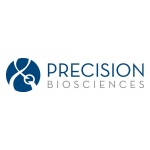ARTICLE AD BOX
– OTC Deficiency Gene Insertion Program, ECUR-506, Receives Clearance from Australian Therapeutic Goods Administration for Phase 1/2 Study
DURHAM, N.C.–(BUSINESS WIRE)–Precision BioSciences, Inc. (Nasdaq: DTIL), an advanced gene editing company utilizing its novel proprietary ARCUS® platform to develop in vivo gene editing therapies for sophisticated gene edits, including gene insertion, excision, and elimination, today announced that its partner iECURE has received approval from the Australian Therapeutic Goods Administration for the initiation of a first-in-human Phase 1/2 trial evaluating ECUR-506, incorporating an ARCUS nuclease for the treatment of Ornithine Transcarbamylase (OTC) deficiency in pediatric (or neonatal) patients.
“The acceptance of iECURE’s Clinical Trial Application marks an important milestone for patients with OTC deficiency and for both the iECURE and Precision BioSciences teams. This is the first ARCUS in vivo gene editing program to progress into the clinic,” said Michael Amoroso, Chief Executive Officer of Precision Biosciences. “We look forward to supporting iECURE’s continued progress with this program while working expeditiously to advance our wholly-owned hepatitis B virus program towards an anticipated clinical trial application (CTA) and/or investigational new drug (IND) filing in 2024.”
OTC deficiency, the most common urea cycle disorder, is an inherited metabolic disorder caused by a genetic defect in a liver enzyme responsible for the detoxification of ammonia. Individuals with OTC deficiency can build up excessive levels of ammonia in their blood potentially resulting in devastating consequences, including irreversible neurological damage, coma and death. The severe form of the condition emerges shortly after birth and is more common in boys than girls. The only corrective treatment for early onset severe OTC deficiency is a liver transplant. Currently available medical therapies do not correct the disease and do not eliminate the risk of life-threatening symptoms or crises.
In preclinical studies, administration of ECUR-506 resulted in a durable response in nonhuman primates, with up to 28.2% of liver cells demonstrating expression of the human OTC gene at the 1-year time point. A 5% threshold of enzymatic activity has the potential for clinical benefit as previously identified in Annals of Clinical and Translational Neurology. Separately, in a mouse model of OTC-deficiency, the injection of ECUR-506 in newborn mice efficiently inserted a healthy copy of the OTC gene.
“At Precision, we have taken a methodical approach in the development, optimization, and validation of ARCUS as a differentiated tool that is uniquely suited for high efficiency gene insertion due to its unique cut which drives homology directed repair (HDR). As presented in preclinical work at the European Society of Gene & Cell Therapy (ESGCT) 30th Annual Congress earlier this year, current ARCUS nucleases demonstrated 17 times higher gene insertion efficiency in primary human T-cells compared to CRISPR-Cas9. In addition, ARCUS showed up to approximately 45% insertion when administered by lipid nanoparticle along with an adeno-associated virus carrying a gene insertion template in adult non-human primates, and demonstrated high efficiency gene insertion via HDR in nondividing, primary human hepatocytes. Today’s announcement of a regulatory clearance for human clinical trials further validates our ARCUS approach and highlights its potential to deliver a curative treatment for patients with OTC deficiency,” said Jeff Smith, Ph.D., Chief Research Officer at Precision BioSciences. “ECUR-506 is the first of several partnered and wholly owned gene editing programs leveraging ARCUS in differentiated indications and we look forward to initial clinical data from this program.”
About Precision BioSciences, Inc.
Precision BioSciences, Inc. is an advanced gene editing company dedicated to improving life (DTIL) with its novel and proprietary ARCUS® genome editing platform that differs from other technologies in the way it cuts, its smaller size, and its simpler structure. Key capabilities and differentiating characteristics may enable ARCUS nucleases to drive more intended, defined therapeutic outcomes. Using ARCUS, the Company’s pipeline is comprised of in vivo gene editing candidates designed to deliver lasting cures for the broadest range of genetic and infectious diseases where no adequate treatments exist. For more information about Precision BioSciences, please visit www.precisionbiosciences.com.
About iECURE
iECURE is a gene editing company focused on developing therapies that utilize mutation-agnostic in vivo gene insertion, or knock-in, editing for the treatment of liver disorders with significant unmet need. iECURE’s approach has the potential to replace and restore the function of a dysfunctional gene, regardless of mutation, by knocking-in a healthy copy of that gene to offer durable gene expression and long-term, potentially curative, therapeutic benefit. iECURE is collaborating with the University of Pennsylvania’s Gene Therapy Program (GTP) led by James M. Wilson, M.D., Ph.D., to utilize GTP’s world-class translational expertise and infrastructure. For more information, visit iecure.com.
Forward-Looking Statements
This press release contains forward-looking statements within the meaning of the Private Securities Litigation Reform Act of 1995. All statements contained in this press release that do not relate to matters of historical fact should be considered forward-looking statements, including, without limitation, statements regarding the potential of an ARCUS gene editing approach as a curative treatment for OTC deficiency, including durability of response, anticipated timing of a CTA and/or IND filing for wholly-owned programs, the ability and differentiation of ARCUS for high efficiency gene insertion and driving homology directed repair, expected safety, efficacy, and benefit of our gene editing approaches, and anticipated timing of initial clinical data. In some cases, you can identify forward-looking statements by terms such as “aim,” “anticipate,” “approach,” “believe,” “contemplate,” “could,” “estimate,” “expect,” “goal,” “intend,” “look,” “may,” “mission,” “plan,” “possible,” “potential,” “predict,” “project,” “pursue,” “should,” “target,” “will,” “would,” or the negative thereof and similar words and expressions.
Forward-looking statements are based on management’s current expectations, beliefs and assumptions and on information currently available to us. These statements are neither promises nor guarantees, but involve number of known and unknown risks, uncertainties and assumptions, and actual results may differ materially from those expressed or implied in the forward-looking statements due to various important factors, including, but not limited to: our ability to become profitable; our ability to procure sufficient funding to advance our programs; risks associated with raising additional capital and requirements under our current debt instruments and effects of restrictions thereunder; our operating expenses and our ability to predict what those expenses will be; our limited operating history; the success of our programs and product candidates in which we expend our resources; our limited ability or inability to assess the safety and efficacy of our product candidates; our dependence on our ARCUS technology; the risk that other genome-editing technologies may provide significant advantages over our ARCUS technology; the initiation, cost, timing, progress, achievement of milestones and results of research and development activities, preclinical studies and clinical trials; public perception about genome editing technology and its applications; competition in the genome editing, biopharmaceutical, and biotechnology fields; our or our collaborators’ ability to identify, develop and commercialize product candidates; potential product liability lawsuits and penalties against us or our collaborators related to our technology and our product candidates; the U.S. and foreign regulatory landscape applicable to our and our collaborators’ development of product candidates; our or our collaborators’ or other licensees’ ability to advance product candidates into, and successfully design, implement and complete, clinical or field trials; our or our collaborators’ other licensees’ ability to advance product candidates into, and successfully design, implement and complete, clinical or field trials; potential manufacturing problems associated with the development or commercialization of any of our product candidates; delays or difficulties in our and our collaborators’ ability to enroll patients; changes in interim “top-line” and initial data that we announce or publish; if our product candidates do not work as intended or cause undesirable side effects; risks associated with applicable healthcare, data protection, privacy and security regulations and our compliance therewith; the rate and degree of market acceptance of any of our product candidates; the success of our existing collaboration agreements, and our ability to enter into new collaboration arrangements; our current and future relationships with and reliance on third parties including suppliers and manufacturers; our ability to obtain and maintain intellectual property protection for our technology and any of our product candidates; potential litigation relating to infringement or misappropriation of intellectual property rights; our ability to effectively manage the growth of our operations; our ability to attract, retain, and motivate key executives and personnel; market and economic conditions; effects of system failures and security breaches; effects of natural and manmade disasters, public health emergencies and other natural catastrophic events; effects of sustained inflation, supply chain disruptions and major central bank policy actions; insurance expenses and exposure to uninsured liabilities; effects of tax rules; risks related to ownership of our common stock; our ability to meet the requirements of and maintain listing of our common stock on NASDAQ or other public stock exchanges and other important factors discussed under the caption “Risk Factors” in our Quarterly Report on Form 10-Q for the quarterly period ended September 30, 2023, as any such factors may be updated from time to time in our other filings with the SEC, which are accessible on the SEC’s website at www.sec.gov and the Investors page of our website under SEC Filings at investor.precisionbiosciences.com.
All forward-looking statements speak only as of the date of this press release and, except as required by applicable law, we have no obligation to update or revise any forward-looking statements contained herein, whether as a result of any new information, future events, changed circumstances or otherwise.
Contacts
Investor and Media Contact:
Mei Burris
Senior Director of Finance and Controller
Mei.Burris@precisionbiosciences.com
Source link
The content is by Business Wire. Headlines of Today Media is not responsible for the content provided or any links related to this content. Headlines of Today Media is not responsible for the correctness, topicality or the quality of the content.
.png)
 1 year ago
13
1 year ago
13










 English (US)
English (US)